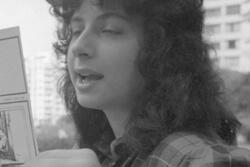From the Archive: 'Tikkun Ha-Olam, Finding Home Series #46' by Siona Benjamin
What We Found
Take a look at this painting, Tikkun Ha-Olam, Finding Home Series #46 (2000) by Siona Benjamin from the Posen Library of Jewish Culture and Civilization. Benjamin, a Jewish Bene Israel woman from India, now lives in the United States. The rich imagery depicted in Tikkun Ha-Olam reflects her multicultural background. Each aspect of this painting gestures to multiple religions, histories, and mythologies, expanding our understanding of Jewish culture: The blue-skinned figure stands on a lotus against a rich, red background, her seven limbs extending upwards. Dressed in a two-piece sari, a women’s garment from the Indian subcontinent, the many limbs of the figure intimate both a Krishna or Kali-like deity and a seven-branched menorah. At the end of each limb appears a hand, stylized as a hamsa, decorated with henna, a natural dye used to adorn the skin, often for special occasions like marriage celebrations. A flame crowns each hand. To the figure's right, the phrase tikkun ha-olam expresses the Jewish concept of repairing the world. To her left, the phrase is translated into Devanagari, the script used to write Sanskrit, Prākrit, Hindi, Marathi, and Nepali languages. In the bottom left corner lurks a serpent, or naga in Sanskrit, a semi-divine being. Snakes also appear in the Torah and Midrash, particularly those on Eve, Lilith, and Moses. Across from the serpent, a lion blows a horn, perhaps a shofar, calling to mind both the Lion of Judah and the Hindu Narasimha, an incarnation of the god Vishnu. The gold border that frames the blue figure evokes Persian miniature paintings and illuminated manuscripts. The bright colors, inspired by American pop art, evoke the vibrancy of Bollywood films.
Why It Matters
The coexistence of these symbols and their multiple meanings derives from Benjamin’s life. Like much of her work, Tikkun Ha-Olam draws upon the ornate synagogues and the predominantly Hindu and Muslim society of her youth, her education in Catholic and Zoroastrian schools, her Jewish, Bene Israel heritage, and her current home in the United States. In art and life, each of these cultures coexist and interact, creating layers of meaning for the artist and the viewer.
Tikkun Ha-Olam is one of many self-portraits in the Finding Home series in which Benjamin paints herself with blue skin. Many artists and worshippers depict Hindu deities, particularly Krishna, in blue. For Benjamin, “Blue skin has become a symbol for me of being a Jewish woman of color.…Very often, I look down at my skin and it has turned blue. It tends to do that when I face certain situations of people stereotyping and categorizing other people who are unlike themselves,” she writes. Benjamin’s blue skin asks us to discard the categories we’ve constructed, particularly about who and what we consider Jewish. In the documentary Blue Like Me she explains that blue is also the color of the “sky and the ocean, and that stretches all over the world, and so I could belong everywhere and nowhere at the same time.” Thus, blue intimates both the experience of difference and the search for belonging.
Benjamin painted Tikkun Ha-Olam in 2000. It is a piece of contemporary art and, simultaneously, a valuable historical source. Tikkun Ha-Olam documents the experience of a Jewish woman of color in our time, the trajectory of her life, and the encounters between her cultures in the mid to late nineteenth and early twentieth centuries.
The layering of religious, cultural, historical, and mythological meanings in Tikkun Ha-Olam also gestures towards the historical roles of women in the Bene Israel community as agents of syncretism in India, blending elements of different cultures into a coherent unity. Bene Israeli women have long been preparing foods influenced by the foodways of their Hindu and Muslim neighbors while maintaining Jewish dietary laws, painting henna on Jewish brides-to-be, and, in the nineteenth and twentieth centuries, attending schools and entering professional fields alongside middle and upper-middle-class women of other religious backgrounds in India. From Benjamin’s use of “recycled mythology,” we can learn to reflect on how each of us is shaped by the cultures, ideas, and myths we’ve come into contact with.
Learn More
If you’re interested in the history of the Bene Israel, take a look at this article covering the historical roles of women in the community. In 2011, Siona Benjamin received a Fulbright to India, where she produced a series of forty photo-collage paintings, “Faces: Weaving Indian Jewish Narratives.” You can see each of the photo-collage paintings and meet those pictured on Benjamin’s website.
[Editor's Note: To learn more about Siona Benjamin and her work, check out our podcast interview with her, and register for our Quarantine(ish) Book Talk on Thursday, July 28, 2022.]
This post is part of JWA’s From the Archive column. It was written in partnership with The Posen Library of Jewish Culture and Civilization.









